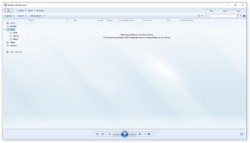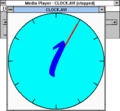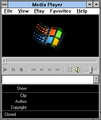Windows Media Player
| Component of Microsoft Windows | |
 Windows Media Player in Windows 10 | |
| Introduced in | Windows 3.0 with Multimedia Extensions 1.0 |
|---|---|
Windows Media Player, or Media Player, refers to a family of multimedia player and library applications developed by Microsoft and normally included with Microsoft Windows. Depending on the Windows version, there might be multiple distinct versions of the application, all using a similar name but including different features.
A multimedia player, then called Media Player, was originally introduced as a part of Windows 3.0 with Multimedia Extensions 1.0, where it was implemented using the Media Control Interface. A slightly updated version of the player then shipped with Windows 3.1. A larger update was included with the Video for Windows suite; this version of the player would be then ported to 32-bit Windows and included with Windows NT 3.1, Windows 95 and later, all the way until Windows Server 2003.
In 1998, Microsoft first released the Windows Media Player, a new player which is unrelated to the MME player. The first edition, often called the "classic" Windows Media Player, had a fairly short lifetime, as it was only officially bundled with Windows 98 Second Edition and Windows 2000 as version 6.1 and 6.4, respectively. However, it continued to be bundled with newer player versions, albeit hidden. Version 7.0, released in 2000 along with Windows Me, introduced a brand new interface partially based on scrapped Music Center work done for Windows Neptune. Later versions up to and including 12 included additional UI changes and feature additions. Microsoft ceased active development of Windows Media Player after Windows 7 was released in 2009, making Windows Media Player 12 the final version of Windows Media Player.
Even though Windows 8 introduced the Microsoft Movies & TV and Groove Music apps for video and music playback, Windows Media Player still continues to be included in later versions of Windows. The name Media Player was revived in Windows 11 as Microsoft redesigned the Groove Music app to also support video playback. The new version was first introduced in November 2021 and was then publicly released to all users in February 2022. In order to distinguish it from the modern Media Player application, the older player was renamed to "Windows Media Player Legacy" in the Windows 11 2022 Update.
History[edit | edit source]
The first version of Windows to include a media player is Windows 3.0 with Multimedia Extensions 1.0. Slightly updated versions of the player then shipped with Windows 3.1 and later revisions of the 16-bit Windows environment. The player is implemented using the Media Control Interface, an extendable API introduced with the Multimedia Extensions. By default, MCI only supports playback of wave audio and MIDI files as well as CD Audio, although support for other formats and devices can be added by installing additional so-called MCI drivers. Although Windows 3.1x does not include MCI drivers for any video format, the player is still capable of video playback if one is added post-install, displaying the video content in a separate window.
A larger update, internally called "Media Player 2", was introduced as a part of the Video for Windows suite and included an updated user interface and support for copying media to documents via OLE. The suite also includes an MCI driver for the new AVI format. This version was later ported to 32 bits with some minor changes and included with Windows NT 3.1, Windows 95 and later. It would continue to be bundled with Windows even after the newer versions were introduced, with the last version of Windows to include it being Windows Server 2003.
Except for the versions bundled with the Multimedia Extensions and Video for Windows, this original incarnation of the player didn't adopt its own versioning scheme and instead used the Windows version number.
Media Player in MDK Version 59
Media Player in Windows 3.0 with Multimedia Extensions 1.0
Media Player in Windows for Workgroups 3.11
Media Player in Windows NT 3.5
Media Player in Windows 95
Windows Media Player 5 and 6[edit | edit source]
In 1996, Microsoft introduced the NetShow multimedia framework for network broadcasting and along with it developed the new NetShow Player to support the platform's then-new ASF container format. The first two versions of the player were rather rudimentary and only supported ASF format playback. At the same time, ActiveMovie, the successor to Video for Windows that also added support for MPEG playback, was also introduced, together with its own player called ActiveMovie Control.
Two years later, ActiveMovie was renamed to DirectShow and incorporated into the DirectX suite. Work also started on a new version of the NetShow Player with a new user interface that would also adopt DirectShow for media playback. However, as the company relaunched NetShow as Windows Media and aligned its version with DirectX, the player was rebranded and NetShow Player 3.0 ultimately shipped as Windows Media Player 5.2. Multiple updates were then released to the player in the following months, eventually bringing it up to version 6.4.
This edition was only officially bundled with Windows 98 Second Edition and Windows 2000 in version 6.1 and 6.4 respectively, although it is also included together with newer player versions in Windows Me, Windows XP and Windows Server 2003, albeit hidden. This edition started to be often called the "classic" Windows Media Player after the introduction of the new user interface in newer versions. The Classic skin, which closely replicates the older user experience, is included up to version 9. Several open source projects, namely Media Player Classic and its forks, also aim to clone the user experience of Windows Media Player 6.4 while also adding features found in newer multimedia players.
Windows Media Player 5.2 Beta on Windows 3.1
Windows Media Player 5.2 on Windows 95
Windows Media Player 7 and onwards[edit | edit source]
Initially planning to continue the older code of Windows Media Player 6.4 as seen in some Beta 1 builds of Windows Me, Microsoft decided instead to create a new Windows Media Player application from scratch, which not only should have the ability to playback media files, but also audio CDs and video DVDs (including rip functionality), so that it not only replaces the older Windows Media Player, but also the CD/Deluxe CD and DVD Player applications from Microsoft Plus! It is also customizable by the use of skins. A near-final version is included in Windows Me. In 2001, an updated version 7.1 was released.
Windows Media Player 8 (also known as Windows Media Player for Windows XP) is only available as a part of Windows XP, though it can also be installed unofficially on Windows 2000. It introduced a new design that fits into the Luna design language of Windows XP, though some skins retained their design of version 7.
Windows Media Player 10 introduced music store integration (which defaulted initially to MSN and later to Bing) and a music library, making it a competitor to iTunes.
Windows Media Player 11 introduced a design that fits into the Aero design language of Windows Vista. A near-final version was ported to Windows XP, hence the different logo compared to Vista.
Windows Media Player 12 introduced a redesign of the user interface that is much lighter, brighter and cleaner compared to the UI design of Windows Media Player 11. It was not made available as an out-of-band update for previous versions of Windows unlike prior versions. It was the last version of Windows Media Player to be released as Microsoft ceased future development of Windows Media Player after Windows 7 was released in late 2009.
Windows 8 would introduce modern replacements for Windows Media Player in the form of the Xbox Video and Xbox Music apps which retained local media playback functionality but with the ability to purchase such media through the Xbox Live Marketplace. The Media Guide and DVD playback features were removed from Windows Media Player. The Xbox Video and Xbox Music apps were later rebranded as Microsoft Movies & TV and Groove Music with the release of Windows 10.
In Windows 11, Microsoft rebranded Groove Music as Media Player and was redesigned to support the playback of video content along with introducing a redesigned UI to fit in with the design language of Windows 11. Windows Media Player was deprecated in favor of the new Media Player app as the legacy Windows Media Player app was renamed to Windows Media Player Legacy in the Windows 11 2022 Update. The device sync functionality would later be removed in Copper build 25151.
Windows Media Player 11 on Windows XP
Versions[edit | edit source]
Compatibility[edit | edit source]
| Windows 3.0 with Multimedia Extensions 1.0 | Windows 3.1x | Windows NT 3.1 | Windows 95 | Windows 98 | Windows 98 Second Edition | Windows 2000 | Windows Me | Windows 2000 Service Pack 2 | Windows XP | Windows XP Service Pack 2 | Windows Server 2003 | Windows Server 2003 Service Pack 1 | Windows Vista | Windows 7—8.1 | Windows 10/11 | |
|---|---|---|---|---|---|---|---|---|---|---|---|---|---|---|---|---|
| Media Player | Y | Y | N | N | N | N | N | N | N | N | N | N | N | N | N | N |
| Media Player 2 | N | A | Y | Y | Y | Y | Y | Y | Y | Y | Y | Y | Y | N | N | N |
| Windows Media Player 5.2 | N | A | N | A | A | N | N | N | N | N | N | N | N | N | N | N |
| Windows Media Player 6.0 | N | N | N | A | A | N | N | N | N | N | N | N | N | N | N | N |
| Windows Media Player 6.1 | N | N | N | A | A | Y | N | N | N | N | N | N | N | N | N | N |
| Windows Media Player 6.4 | N | N | N | A | A | A | Y | Y | Y | Y | Y | Y | Y | N | N | N |
| Windows Media Player 7.0 | N | N | N | A | A | A | A | Y | N | N | N | N | N | N | N | N |
| Windows Media Player 7.1 | N | N | N | N | A | A | A | A | Y | N | N | N | N | N | N | N |
| Windows Media Player 8 | N | N | N | N | N | N | N | N | N | Y | N | N | N | N | N | N |
| Windows Media Player 9 | N | N | N | N | N | A | A | A | A | A | Y | Y | N | N | N | N |
| Windows Media Player 10 | N | N | N | N | N | N | N | N | N | A | A | A | Y | N | N | N |
| Windows Media Player 11 | N | N | N | N | N | N | N | N | N | N | A | N | N | Y | N | N |
| Windows Media Player 12 | N | N | N | N | N | N | N | N | N | N | N | N | N | N | Y | Y |
| Media Player (Groove) | N | N | N | N | N | N | N | N | N | N | N | N | N | N | N | Y |
Legend:Not available Available Preinstalled
| ||||||||||||||||












